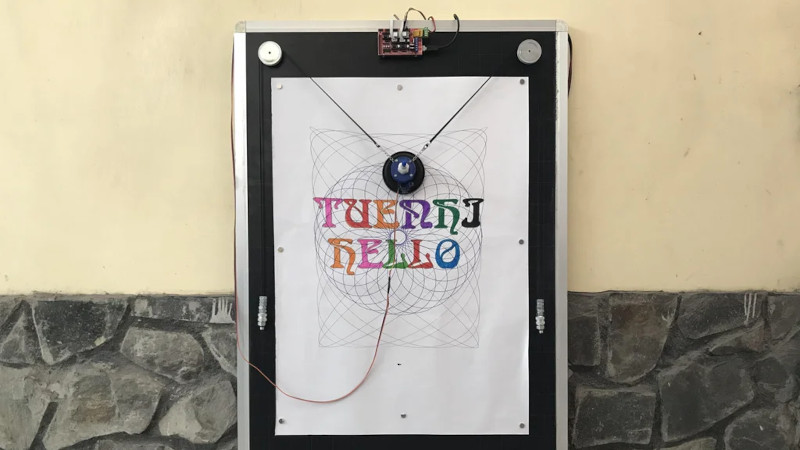Printers are all well and good, but they’re generally limited to smaller paper sizes and use expensive ink. If you instead want to produce art on a larger scale, a plotter can be a great way to go. [tuenhidiy] built a tidy example using an old blackboard as a base.
These days, such a build is quite easily approachable, thanks to the broad DIY CNC and 3D printing communities. The plotter consists of a pair of stepper motors, driven by an off-the-shelf RAMPS 1.4 controller and an Arduino Mega 2560. The motors are mounted at the top corners of the blackboard, and move the pen holder via a pair of toothed belts, counter-weighted for stability. The pen holder itself mounts a simple permanent marker, and uses a servo to push the holder away from the paper for retraction, rather than moving the pen itself. Control of the system is via the Makelangelo firmware, an open-source effort capable of driving a wide variety of CNC motion systems.
The final result is a simple plotter using readily available parts that can reliably plot large graphics on a piece of A1 paper. We’re particularly impressed by the clean, continuous lines it produces – testament to a sound mechanical design.
We see plenty of plotters around these parts; even rotary types that can draw on curves. Video after the break.















Let’s give Dan Royer at Marginally Clever a shout out who is behind the software and has spent a lot of time developing the Makelangelo firmware. If you don’t feel like building one from scratch you can get a great kit from him.
http://www.makelangelo.com/
In b4 some dink says they would have used a pi to drive steppers
Why use an old blackboard? Just attach the thing directly to the wall, for much bigger plots.
Also this would be a great way of applying a wallpaper design, or indeed a mural directly onto a wall, assuming it’s flat enough.
“Old” implies to me that it was hanging around unused, so was repurposed. Walls don’t necessarily work that well for this kind of plotter, they do better at a slight angle, otherwise you have to have rigid arms to keep the implement pressed to the work.
Though if you’re really wanting to do it on walls, you could try a fan, impeller, blower, drone rotors etc to push it to the surface by hurling air in the opposite direction. Or use magnetic or electrostatic methods.
On third thoughts… can still apply gravity by some kind of stick on two strings, stick applies it’s weight at angle to a pivot, balljoint or UJ type arrangement on the plotter head, whatever you can get working smooth and won’t bind, and top end is suspended by strings from top. Adds inertia to whole arrangement though, however, if the design put mass in the head to keep it down on an angled board, that could be deleted as much as possible.
Just use spray paint. Jürg Lehni & Uli Franke did that 19 years ago.
http://juerglehni.com/works/hektor/